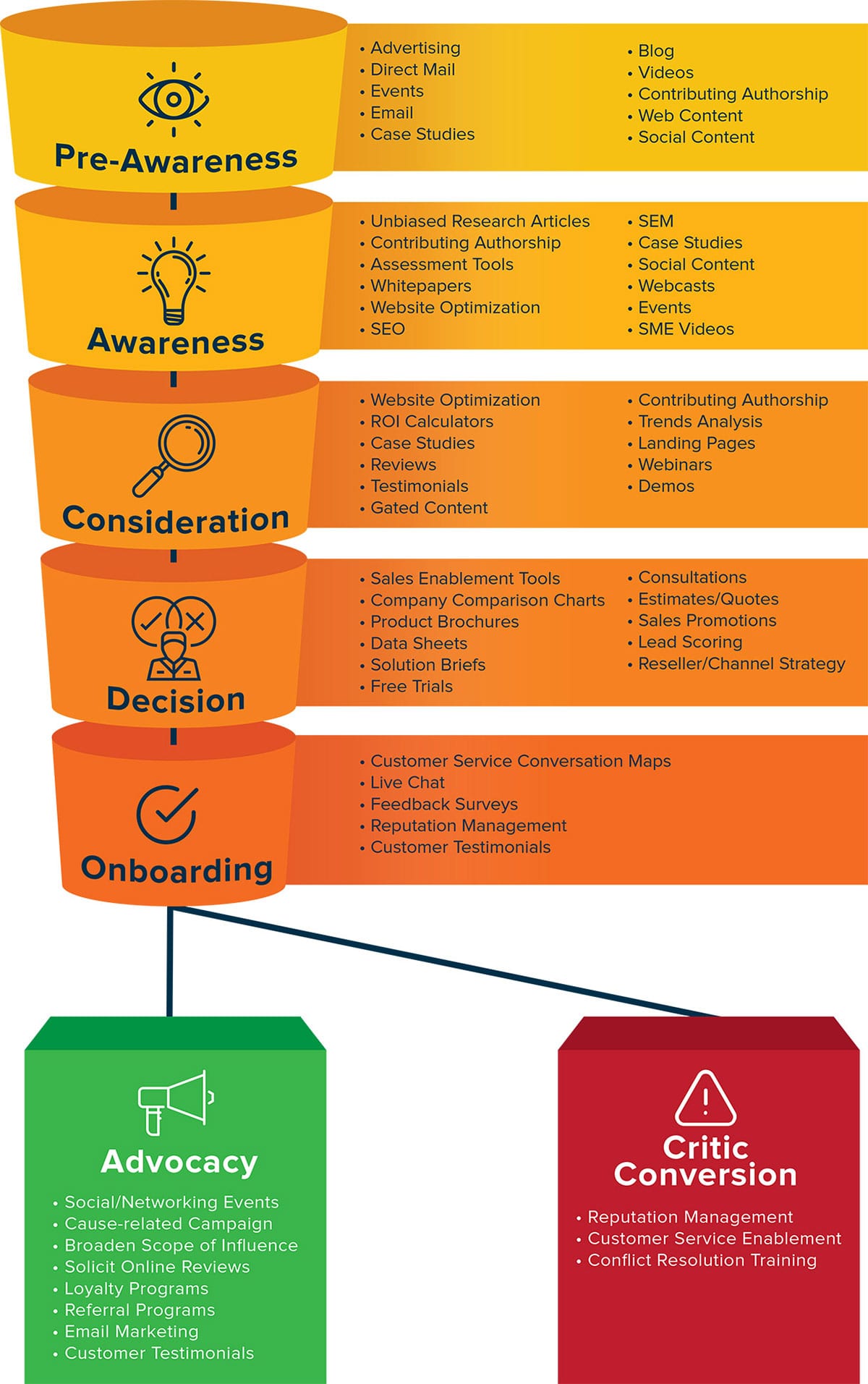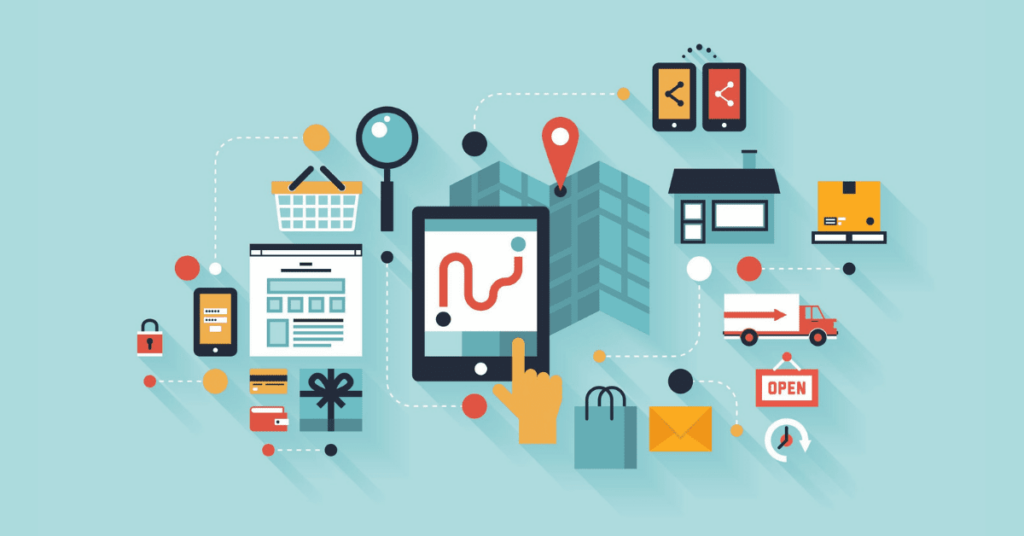Tony Zambito recently wrote “Buyers today behave more akin to being on a quest for knowledge. On a quest to find an answer. On a quest to discover a way to solve an issue or an urgent problem.” The truth is that B2B buyers aren’t buying your product or service, they’re solving a problem. Our job as marketers is to help them understand and solve their greatest problems with no self-serving strings attached.
The fundamental shift here is moving away from “How do we drive leads?” to “How do we understand our customers well enough to provide answers that are relevant, timely and truly helpful in solving their problems?”
To get that level of understanding, we recommend tapping into multiple data inputs: customer interviews, conversations with sales teams, analyzing your Google and social analytics, leveraging 3rd party market research, and targeted surveys.
This information can then be analyzed and organized into a usable buyer’s journey that should be printed and pasted on every marketer’s wall. This should also guide every one of your strategies from content to keywords, events to social channels and beyond.
Adding Insight to Your Buyer’s Journey
Most buyer’s journeys show the standard 3-step journey: Awareness, Consideration and Decision. What we are proposing is a new way to think about this journey, with new stages aligned to today’s buying behavior, and additional insight included for each buyer persona, at each stage.
- What triggers them to begin their search? (This is only relevant to start the journey, not each stage)
- What questions do they need answered at each stage?
- What event or feeling is motivating them at each stage? (Promotion at work, RFP, fear, overwhelmed, etc.)
- Where do they go for information during each stage?
- How are we helping them during each stage?
- How will we measure success at each stage? (KPIs, data sources, etc.)
A New Look at the Buyer’s Journey
The model we are proposing here widens the view and adds more detail to the typical 3-step or 4-step journey.
- Pre-Awareness / Identified Need
Most journey maps neglect this crucial phase all-together, and silo “brand awareness” or “demand gen” activity to fill the void. At this stage, your customers may have a problem (presumably that you can solve) that they either don’t know they have, aren’t aware there’s a solution, or don’t know the impact that problem could be having on their success. Your marketing strategy at this stage needs to speak directly to these problems and their impact. Here we have an opportunity to make them question the efficacy of what they are currently doing, and instill a bit of urgency for those who genuinely have a need. - Awareness / Research
Once they identify their problem and understand it could be having a bigger impact than they originally thought possible, they officially begin a fervent quest for knowledge. At this phase, the status quo begins to loosen and they are open to changing what they have typically done. It’s tempting to go in for the close here (gated content, contact us), but that’s where most marketers and sellers fail. Your perspective customers aren’t ready to give you their information yet, and you haven’t earned their trust. The key here is to be present when and where they are looking, and to provide unbiased guidance to help them educate themselves about the problem. - Consideration / Narrow Search
If you’ve done a good job of educating them in their early research phase, they will naturally ask themselves, “Can you help me solve this problem? Are you qualified?” This is where Seth Godin’s book, This Is Marketing, becomes invaluable. Having a clear brand strategy will help position you as the perfect solution to their specific problems. However, an effective brand strategy will also weed out people that aren’t the right fit for you. This can be scary to marketers looking to “drive more leads”, but you have to ask yourself what you want more; a higher number of unfit leads that you need to adjust your offering to serve? Or a smaller quantity of high-quality, highly winnable leads, that already love what you do and will be better long-term customers and referral sources? - Decision / Commitment
Once you’ve established trust and credibility, we move from right brain to left brain. Now your sales team, product and operations managers can do what they do best by beginning to highlight how your product/service compares to competitors . This is the stage where lead generation becomes a focus, so creating truly valuable offers that entice potential customers to give you their information is key. Free consultations, demos, customized quotes/proposals and other personalized resources will drive leads into the sales funnel. - Onboarding
We often find that when marketers think post-purchase (i.e. nurture), they think “up-sell/cross-sell”. This is dangerous territory. It’s important to acknowledge that no matter how well you have nurtured your customer through the process, it is totally normal for every one of your customers to question if they’ve made the right decision. Your COO, VP Sales and Customer Service team should provide the tools and training to enable a seamless onboarding process to address their remorse, but as marketers, we can reinforce that they made the right decision by continuing to share fresh case studies, testimonials and reviews on all channels so that when they do their “Did I make the right choice?” search, you’re there with fresh data and ideas to reinforce that they chose wisely. - Advocacy
If your marketing strategy is exclusively focused on driving new leads, you’re missing a critical KPI that can make or break a business’s profitability – Customer Lifetime Value (CLV). You’ve probably heard the cost of acquiring a new customer can cost 5x more than retaining an existing customer, and increasing customer retention by a mere 5% can increase profits from 25-95%. To ensure success at this stage, we need to thoughtfully develop programs that help your customers feel good about your brand (back to right brain), and give them easy outlets to share their experience in a way that helps them be the hero by sharing your value to others in their network. Often times this means broadening your scope of influence to become a part of their everyday lives and view them as more than just a customer. - Critic Conversion
It would be naive to think you’re going to make every one of your customers happy every time. It’s how we handle those unfortunate misses that determine whether they are minor bumps in the road or an expensive PR issue. We always recommend our clients be proactive by soliciting feedback soon after purchase. This can be automated via email, or if you’re a low volume business, a personal call or an email goes a long way. Unfortunately, the easiest way for your customers to complain isn’t via your customer service line, it’s Google and social channels. So it’s probably not news that it’s incredibly important to stay on top of your online reviews across all channels. There are tools that can ping you any time someone posts a review and gives you the ability to be proactive and responsive to any and all feedback, in real time. And remember, there’s a right way and a wrong way to respond to reviews.
Tactics
Every client and buyer journey is unique, and we spend a significant amount of time thinking through which tactics make the most sense for each customer journey we build. That said, here are some of the tactics and activities we tend to focus on at each given stage.

Like many “How To” blogs, this process is easy to understand, but difficult to execute effectively. If you would like to discuss how you would approach this for your business, we would love to have a conversation.

